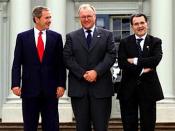1. Do you believe the Bush administration was correct in imposing tariffs in March 2002 on a wide range of steel imports?
At the time President Bush decided to impose temporary tariffs on steel imports, 16 steel manufacturers were operating under bankruptcy and a total of 30 had declared bankruptcy over the prior few years (Hill, 2004). U.S. steel producers were losing market share to foreign steelmakers in large part due to subsidies and other trade issues. Bush and his Cabinet chose to implement the tariffs because of "the need to speed up negotiations to reduce the world's huge overcapacity in steel production," (Business Week, 2002, ö 5). The tariffs were the largest trade-protection grant since President Regan had taken similar steps to shore up the steel industry. President Clinton had ordered a study that was done in 2000 with the resulting information "the U.S. [steel] industry was the victim of foreign subsidies and other unfair trade practices," (Business Week, 2002, ö7) .
Commerce Secretary Donald L. Evans noted that tariffs were needed in order to manage Europe, South Korea and Japan, who were the worst in regard to excess capacity. Conversely, White House Economic Adviser, Lawrence B. Lindley, cautioned that raising tariffs would only make U.S. manufacturers less competitive because it would raise prices, and Secretary of State Colin Powell noted that this move would alienate coalition partners of the war on terrorism. The European Union (EU) retaliated on March 27, 2002, by imposing similar tariffs on steel imports to attempt to prevent a flood of steel imports into the EU. EU President Romano Prodi urged President Bush not to proceed with his "protectionist measures" (CNN.com, 2002). Intended to last for three years, President Bush ended the tariffs on December 4, 2003, one month after the World Trade Organization...


